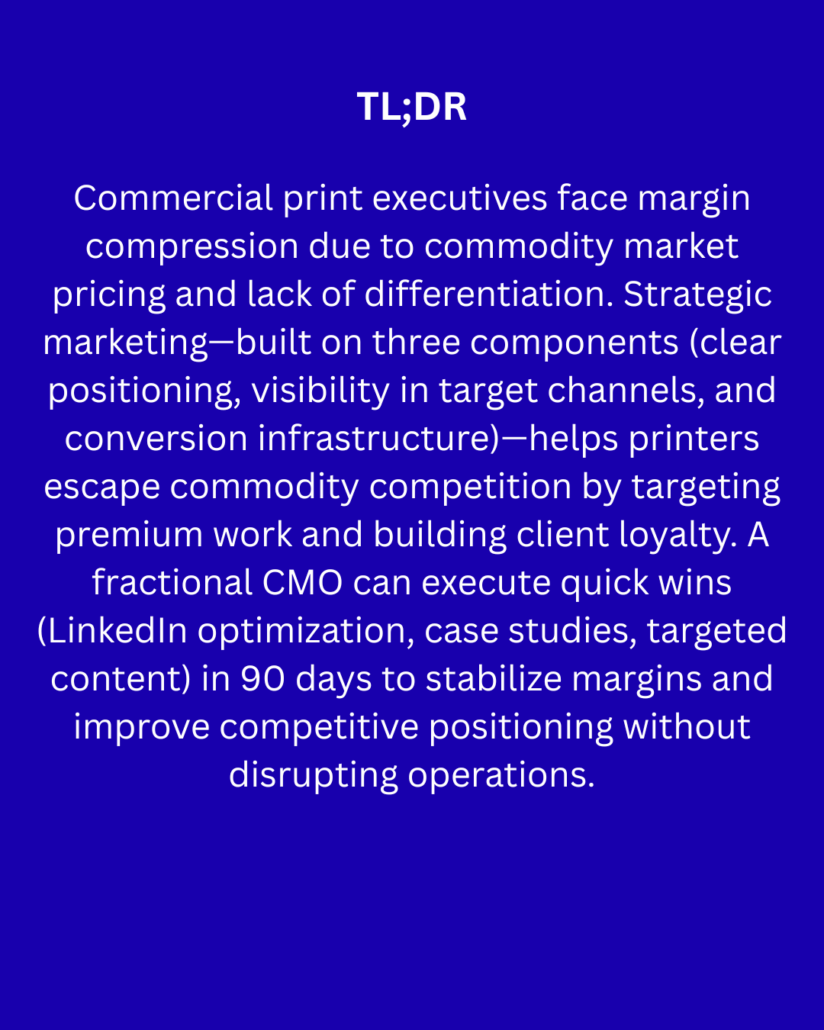Your Marketing Isn’t Delivering? Here’s Why— And What to Do About It
Your press is running. Your team is delivering jobs on-time. But your margins? They’re getting tighter every quarter. You’re competing on commodity metrics—turnaround, price, reliability—while your competitors are doing the same thing. It’s a race to zero, and you know it.
The problem isn’t your operation. Your shop runs solid. The problem is you’re invisible to the exact clients who would pay premium rates for what you do. And you’re stuck in a cycle where the only way to grow is to take more low-margin work from the same bidding pools.
Here’s the truth: in commercial print, marketing isn’t separate from your operations—it’s an extension of them. It’s how you move from commodity to value. It’s how you shift the conversation from ‘What’s your price?’ to ‘Can you handle this complexity?’

The Margin Problem (And Why Marketing Fixes It)
Your costs keep going up. Paper, ink, labor, energy—they don’t come down. So you’re stuck with two bad choices: raise prices or shrink margin. Most print executives choose the third option: take more volume and hope efficiency gains offset the decline. That’s a trap.
The market for commodity work is brutal and transparent. Everyone can price it. Everyone can execute it (or close enough). So the only way to win is to own a different conversation: premium work, complex applications, measurable outcomes for clients.
That shift happens through strategic marketing—not because marketing creates magic, but because it clarifies who you are, what you’re different at, and why it matters to clients who can actually afford to pay for it.
Think of it this way: your best clients aren’t hunting for the cheapest quote. They’re hunting for a vendor who understands their industry, reduces their complexity, and delivers predictable outcomes. They’re willing to pay for that. But they have to know you exist and why you’re worth the conversation.
That’s marketing. And it starts with being visible to the right prospects, in the right channels, with the right message about what you actually solve.
The Three Components of Print-Smart Marketing Strategy
Most print companies treat marketing like a checkbox. You run a few ads, maybe a trade show booth, and call it done. Then you wonder why the phone isn’t ringing with premium opportunities.
Strategic marketing for print isn’t about more noise. It’s about clarity. Here are the three elements that actually move the needle:
- Positioning That Reflects Your Real Competitive Advantage
You’re not competing on ‘we’re a printing company.’ You’re competing on outcomes. Maybe you dominate variable data for direct mail. Maybe you’re the shop that handles complex die-cuts faster than anyone in your region. Maybe your compliance printing for healthcare is locked-in with zero errors. Whatever it is—that’s your position. That’s what goes in front of prospects.
Most printers undersell what they’re actually good at because they’re too close to it. You’ve been running that equipment for 12 years—of course you nail the specs. Your clients outside print have no idea that’s not the norm. Strategic positioning tells them.
- Visibility in the Right Channels (Where Your Ideal Clients Are Looking)
Your ideal clients—marketing directors, procurement leads, brand managers—aren’t scrolling printing trade magazines. They’re on LinkedIn. They’re searching ‘variable data printing solutions’ when a campaign idea hits. They’re asking peers in Slack communities for referrals. They’re reading industry blogs about packaging trends or direct mail ROI.
If you’re not visible in those channels with relevant, helpful content, you don’t exist to them. And visibility doesn’t mean blasting ads. It means showing up consistently with information that answers the questions they’re actually asking. That’s how you build credibility and end up in the consideration set when they’re ready to buy.
- Conversion Infrastructure (From Prospect to Win)
Visibility without conversion is just noise. You need a system that takes prospects from ‘I’ve heard of this shop’ to ‘Let’s get a spec and quote’ to ‘Let’s run a pilot’ to ‘This is our new vendor.’ That system includes a clear quote process, case studies that prove your outcomes, proof points (certifications, client testimonials, on-time delivery track record), and a sales team that knows how to position value instead of just bidding on specs.
Without this infrastructure, visibility just frustrates you. Prospects call with questions you should have already answered. Quotes take weeks to turn. Clients compare you primarily on price because they have nothing else to differentiate on.
When these three components work together, your sales team is no longer fighting uphill against commodity pricing. They’re talking to prospects who already see the value. That changes everything about your close rates and your margins.


Why Your Current Approach Isn’t Working (And What You Should Do Instead)
If you’re running your marketing in-house without strategic direction, you’re probably seeing one of these patterns:
- You’re doing things, but nothing’s moving the needle. You’re posting on LinkedIn. You went to the trade show. You ran a mailer. But your sales pipeline looks the same, and you’re still competing on price.
- Your team is overextended. Marketing is one person’s side job (usually someone in sales or ops). They’re good at their main role, but strategic marketing requires a different skillset and dedicated time. So it doesn’t happen.
- You’ve brought in outside help, but it didn’t stick. An agency created a fancy website or a campaign that looked great but didn’t produce leads. Now you’re skeptical that marketing can even move the needle for a shop like yours.
These patterns all point to the same root cause: marketing without a print-specific strategy. Generic marketing firms don’t understand your business. They don’t know the difference between your competitive advantages and the 50 other printers in your region. So they create generic campaigns that don’t land with your ideal prospects.
What you actually need is a fractional CMO—someone with deep print industry expertise who can build a strategy tailored to your specific position, your ideal clients, and your growth goals. Not someone who’s guessing. Someone who knows that your target market lives on LinkedIn and reads case studies before they call. Someone who can build a marketing system that works in parallel with your sales team, not against it.
How to Get Started (Without Disrupting Your Operation)
You don’t need an overhaul. You don’t need a year-long project. You need clarity: What are you actually good at? Who should know about it? How do they find you?
A fractional CMO starts with a diagnostic: understand your operation, map your ideal client profile, audit your current visibility, and identify 2-3 quick wins that can move the needle in the next 90 days. Those might be:
- Claiming and optimizing your LinkedIn presence with proof points (certifications, client outcomes, on-time track record)
- Creating case studies from your best recent projects that show outcomes (time saved, complexity handled, compliance achieved)
- Building a simple content calendar targeting the channels where your ideal prospects are actually asking questions
- Clarifying your positioning so your sales team has ammunition to move conversations away from commodity pricing
These aren’t massive projects. But done strategically, they shift the conversation. Prospects start seeing you differently. Your sales team has better leads to work with. Your margins stabilize because you’re competing on value, not volume.
And here’s the real kicker: once you have a foundation, a fractional CMO can operate in the background, feeding your sales pipeline and monitoring what’s working, so your team stays focused on what they do best—running a tight operation and delivering excellent work.

The Bottom Line
Margin compression isn’t a production problem. Your operation is solid. It’s a visibility and positioning problem. You’re invisible to the exact clients who would pay premium rates for what you do, and you’re competing on price with people who have the same capabilities you do.
Strategic marketing fixes that. Not generic marketing. Not more noise. Strategic marketing built on a clear understanding of your competitive advantage, visibility in the right channels, and a conversion system that turns prospects into loyal clients.
If you’re ready to move the needle on margin and differentiation, the first step is a conversation. We’ll spend an hour understanding your operation, your goals, and where marketing can actually create impact for your business.
Ready to Stabilize Margin and Build Real Competitive Advantage?
Schedule a No-Obligation Strategy Session
We’ll map your current position, identify 2-3 quick wins, and show you exactly how strategic marketing can impact your margins and growth.
Or reach out directly:
Email: Mark@CMOAdvisers.com
Website: https://cmoadvisers.com/




